
The Vega has been discussed here on RG before, and as expected, there was a cornucopia of opinions on the attractive but rapidly rusting little GM car. But an interesting question that occurred to me a while back is, why didn’t GM offer four-door versions? For that matter, why didn’t Ford do the same with their subcompact Pinto? Many of the import competitors–Datsun 510, Subaru Leone, Toyota Corolla–had them. Even Chrysler’s captive-import Dodge Colt had a four-door wagon.
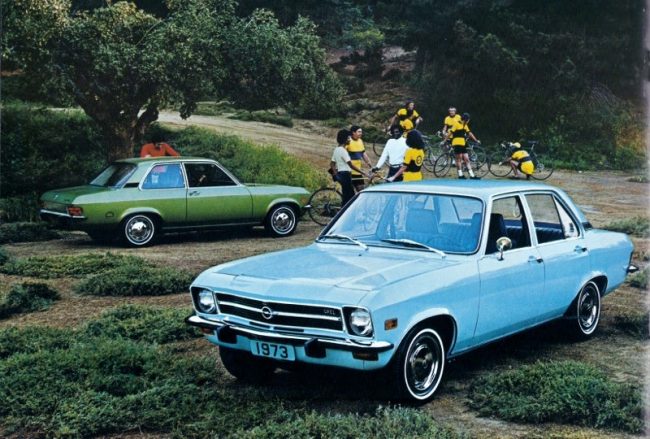
The European Opel Ascona, sold here thru Buick dealers as the 1900, offered a four-door version, albeit as a sedan and not a wagon. With all the money GM spent on their pet project, how much more would tooling a Vega with more than two portals have cost? My guess is they figured most folks who wanted something bigger than a Pinto or Vega longroof could step up and get a Chevelle or Torino/Fairlane.
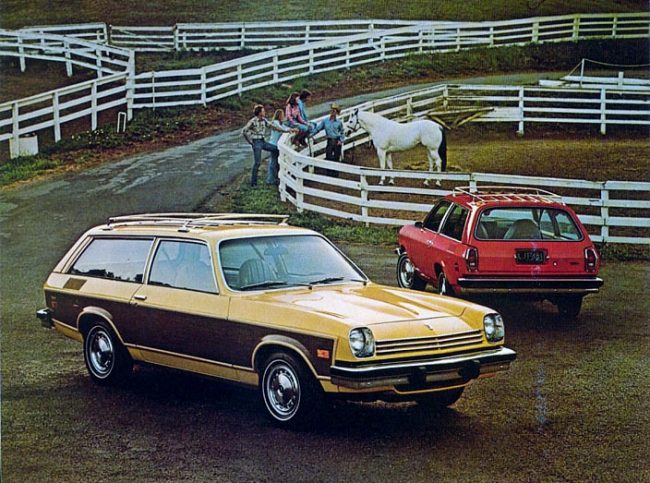
Anyway, by 1976 the Vega was improved, and the wagon was perhaps the best looking Vega of all. If a four-door version had been built, we probably can assume it would have been recycled for the 1978 Monza line, just like the two-door wagon was.
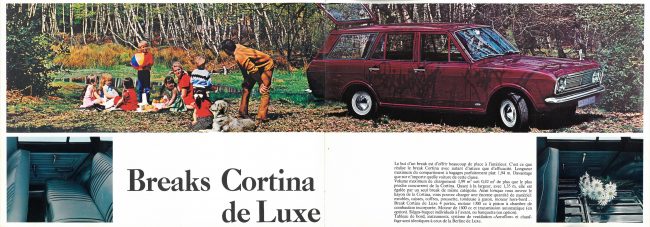
Ford did the same thing with its Pinto: Any model you wanted, even a Broughamed-up Squire wagon-as long as it had two doors–notwithstanding the wagon’s tailgate. But over in Europe, you could get a Cortina four-door wagon. Though about eight Cortinas were sold in the U.S. market, twelve in Canada, ha ha.
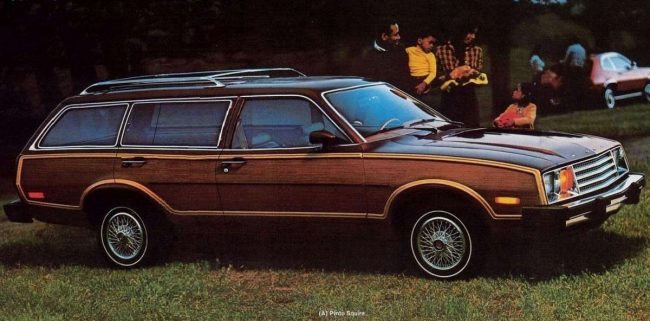
And by the way, for all you Pinto people, my first attempt to Photoshop a four-door Pinto wagon resulted in a concoction so horrible that I deleted it. At any rate, a more suitable picture from oldcarbrochures.com sufficed. May I present the 1980 Pinto Squire four-door wagon? Granted, it has aesthetic challenges too, but it gives one a rough idea of what a quattroporte Pinto wagon may have looked like.
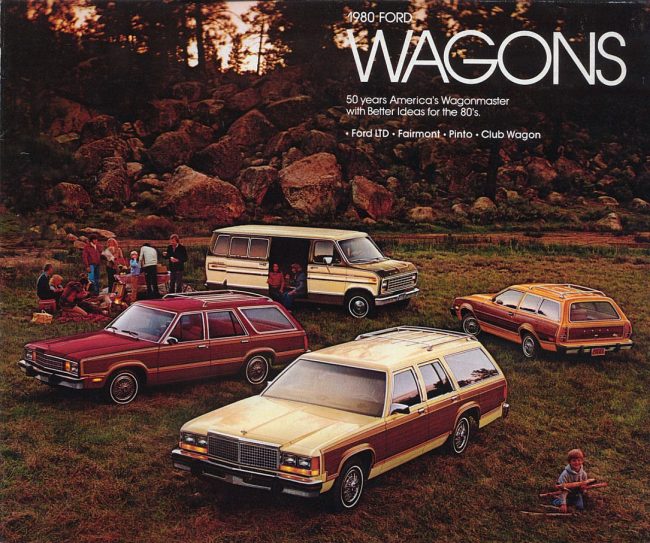
Of course, Ford finally offered a smaller four door wagon with the Fairmont’s debut in 1978. Probably a more logical plan than my late-afternoon musings!







21 Comments
Detroit was still fixated on the Beetle when they were designing the Vega and Pinto, and the Beetle (and Squareback) only came in two doors. Given the worthless backseats in the Vega and Pinto, there would have been little utility to having the extra doors, and child seats were not widely used or nearly as bulky so tossing little ones into the back from the front seat was less of a big deal than it would be today. I also expect that neither the Vega or Pinto were ever more than very very marginally profitable when built with expensive UAW labor, so adding $5 in costs for the extra doors would not doubt have been turned down by the beancounters. And I’m sure you are correct Tom that Chevy and Ford and their dealers were much happier to steer would-be buyers looking for the extra doors into the larger and more profitable Malibu or Torino wagons for only $10 per month more.
It’s also hard to argue they needed the extra doors because they sold tons Vegas and Pintos without the extra doors, and this popularity led to other problems far more serious than missing doors such as poor fit and finish, rapidly rusting bodies, self-destructing engines (Vega), and general lack of comfort, which created the first wave on “never buy and American car again” consumers whose next car was likely something from Japan. Too bad, because the Vega GT wagon was one of the best looking cars of the early 70s, and with decent quality could have become a real icon instead of joke.
In the late 1960s, the big three noticed the youth turning to small cars that also happen to be foreign. They presumed in my mind incorrectly that this was do to a size of car preference and not that half of that generation wanted to divert their money away from the big three as it was part of “The Man”, the establishment, or the silent majority. The big three had already introduced a cheaper full line of compacts but found not only profits smaller but also the horror they were trying to avoid of substituting a low cost model for a big one with larger profits. Notice how short lived the 60s American compact wagons were except at AMC as small car specialist.
Thus this time they tried body styles they hoped would attract the young without canabalizing big car sales. Well than why was there a 3 door wagon? Well GM and Fords cars were heavily influenced by their European operations and urban sedan delivery commercial versions were common there. There were still Pinto wagons delivering the mail in Atlanta into the 90s.
AMC, as the small car specialist understood what they were doing better. So their offering just drastically shortened the compact so much that the back seat was barely there and early even optional.
Early on it worked, Vega and Pinto sold well to the half of the boomers that felt themselves loyal to the system. It also didn’t hurt that it was often parents buying for the kids. Soon enough of course the car media and associated legal arm came for the Pinto and the Vega. Must burn The Man if you want to be gonzo and transfer out of the car journalist ghetto.
I don’t understand why you need to concoct an elaborate sociological model for consumer behavior here. The Vega and Pinto were slow, unreliable, rust-prone garbage. That’s really sufficient explanation for what happened to Big Three market share.
I don’t know how many of these I rode in when I was a kid, staring at the asphalt flying by under the rust-perforated floorboards, or soaking my shoes in a puddle in the footwells, formed as rain or snow had soaked up through the rust holes in the door sills.
I had a 1979 Pinto hatchback for a while. The way the car was shaped and tiny wheelbase, I can’t imagine making a four door out of the coupe (at least) wouldn’t have required major surgery and a different wheelbase (al a Maverick/Comet) to get it functional. These were meant to be inexpensive cars, like the cars they were competing against. The other cars mentioned in your write up were truly world cars. Here in the US, our idea of car was a full sized beast, those Opels, Cortinas and Corollas were the ROW’s idea of a full sized car. That would explain the need to have all the variants offered.
You could make an argument of sorts for the four door wagon versions of the Pinto & Vega, but I don’t think that was the mission of those wagons. For example: had the Falcon/Fairlane wagons (using the Ford cars as examples, you can imagine the GM side) been such a success, there would have been a Maverick version when that car was in production. It didn’t happen, obviously, as the business case wasn’t there.
I think by the early/mid 1970’s, true mid size wagons had taken the compact sized wagon’s position in the market as they were fairly close in cost and offered more utility. Or, the domestic alternative (AMC Hornet) was considered good enough, especially for the price. In my neck of the woods by the mid to late 70’s, if you had a passel of kids, you had a passenger van, not a station wagon.
I owned a Vega. At 75,000 miles and four years old in Texas (no salt on roads) there was terminal cancer rust all over it and the engine consumed a quart of oil every 75 miles, not to mention stalling out about one in ten times on off-throttle acceleration.
The few Pintos I worked on were SLIGHTLY better, a little less rust-prone; the engines lasted a bit longer as they were at least cast iron blocks; but they were still garbage.
The reason people came to hate the Pinto and Vega was not because of some self-loathing desire to “stick it to the Man” – said “Man” supposedly being personified by GM and Ford – and give all their money to the Japanese. No, the reason people came to hate these cars is that they were TERRIBLE CARS.
In fact, I’ll tell you, since I was there and you apparently either weren’t there or your memory has gone, the Japanese cars of the time period sucked too. In let’s say 1976, the only even semi-decent small car for sale in the USA was the German Capri, and it was pretty awful.
However, the Japanese makers, to their credit, learned and started improving. The Americans didn’t. I suppose the Chevette and Escort were marginally better than the Pinto and Vega, but that’s a pretty low bar. By the early 80s some of the Japanese small cars were at least usable, and the VW Rabbit was similarly “usable”.
I’m sorry, but the US automakers needed neither some fantasized “youth cabal to get the American automakers”, nor an international press and media conspiracy, to crater their business with reputations for abysmal quality and reliability. Nope, they did that all on their own.
JC I don’t want to make this personal but I understood your anecdote was directed at me. So what I will say next descibes the generic owner of a Vega. First you can understand the annoyance of parents buying a slow $2000 special when cool cars were only 50 percent more. This was probably compounded by getting one off the lot without the really cheap performace options like the 4speed the two barrel and shorter axle ratio. The car, unlike say all the imports had a bigger engine and tall gearing that allowed interstate travel. A two speed powerglide had a taller final drive ratio than even an SR5 Toyota. Compared to the 15 mph/1000rpm top gear late sixties import it was down right transformative. Notice even with a troublesome engine the generic owner got 75,000 miles of the new found freedom of seeing the USA. This despite driving it constantly a quart low instead of fixing the minor leak or valve issue. Try that in a Fiat or Renault. The generic owner, unlike say the owner of an early Honda who chose his car on politics when he notices rust break out does nothing. The careful owner would instead have caught the rust early fixed it and had the car waxoyled. At the very least wax more often. For a car hated car it just becomes a beater and quickly dies as the owner you know beats on it . The story of most cheap cars. The generic owner got his parents moneys worth and more.
1) There was no way my Vega was suitable for interstate travel. I’m a Texan; I know about long distance driving on the interstate.
2) No cars in Texas in 1978 had terminal cancer rust after four years. It rarely snows, and there is no salt used on the roads. No one here has their car specially treated for rust, because it’s not needed. In my family we typically kept cars for at least 10 years. None of our other (American!!!) cars had ANY visible rust at 10 years.
3) What caused the engine to burn a quart of oil every 75 miles was the poorly-thought-out all-aluminum block combined with cast iron head and iron pistons with aluminum plating. Even the faintest degree of overheating, which a normal engine would tolerate, resulted in a loss of the molecules-thick silicon surface on the cylinder walls and subsequent terminal cylinder wall scoring. Because the cylinder wall surface was created in the factory by a non-reproducible process, it was impossible to bore and hone the block and put new rings. The only solution was to bore out and press fit iron liners. Every general auto catalog of the time sold kits for this. Of course since I bought it used for under $1000, taking the engine down and having all the machining done, etc., was a nonstarter economically.
4) Obviously I didn’t drive the car “constantly a quart low”. If you didn’t keep oil in the thing constantly it would have run bone dry in a couple weeks.
5) Did you see up above where I mentioned the tendency in my family to keep cars for 10+ years? When I think back on cars of the 1960s, 70s and 80s that I and my famly members owned, I can recall:
10 years, 170,000 miles, no oil burning, no rust El Camino – sold because no AC and the shift linkage was constant trouble
10 years, 150+k, no oil burning, no rust Pontiac – sold because my mother wanted a new car
10 years, 200k, no oil burning, no rust Chevy Nova – sold because it became surplus to requirements
20 years, 150k, no oil burning, no rust Chevelle, sold because surplus to requirements
10+ years, 100k, no oil burning, no rust Buick, sold because my mother wanted a new car
17 years, 200k, no oil burning, no rust Mazda, sold because I wanted a new car
20 years, 250k, no oil burning, no rust Volvo, sold because I wanted a new car
15 years, 150+k, no oil burning, no rust Toyota, sold because my wife wanted a new car
And!!!
4 years, 75,000 miles, burning a quart of oil every 75 miles, terminal cancer rust Vega.
Can’t you realize that your wholly made-up narrative about some kind of evil cabal dedicated to destroying the American auto industry that somehow magically made one of 10 cars owned and operated by basically the same people under similar maintenance regimens a total bomb just because it was an American car (unlike all those imported El Caminos and Pontiac Catalinas and Buick Centurys and Chevelles) – is just totally nonsense?
What car did you want your parents to buy you when they bought you the Vega?
John, John, John, I know you do this just to get a reaction and normally I would not jump in, but JC is on point, a lot of American made cars would last a decade or two with regular maintanance. I have three that are four decades old. I have been driving sence I my mom taught me to drive on our farm when I was 12 and we have always owned American cars. Just, like the examples JC provides I could provide 2X more but that would be overkill. The truth is the Pinto and Vega were designed on the cheap, the base line MSRP was chosen and the cars were made to a quality standard to meet the base MSRP. In the case of the Pinto that base was $1,995. design, engineering, materials, and assembly were all done to fall below that MSRP and the results show. John, you are most likely more well read then I, so you most likely know, that the ball of flame Pintos could have been prevented by a single plastic shield as documents from FMC showed at trial. but even the cost of the plastic shield would have had an effect on meeting the preestablished price target so it was left out. I really don’t like to say that the Pinto and Vega were the low water marks of American automotive manufactuing but they were. John it is just true. It is not a knock on American manufacturing… Ok I have talked enought.
Be Careful Out There….
Lynn the reaction I hope to get is people think more about the Vega than some blanket condemnation. I understand you like the big cars, I do too and America back then had a talent for them. When facing small Japan and other imports with stolen tech and wage rates then less than 25% of UAW if GM was trying to be cheap they could have assembled in Mexico a shortened Nova resembling a Gremlin with a Superthrift 153 or the Chevy Luv engine. Instead was a clean sheet expensive aluminum engine that saved 50 pounds, improved economy and added high end power especially noticeable with the German stick shift. Given the prices being paid and comparable import engine lives, 75k miles should satisfy especially in a car aimed at the entry level youth. The number of youth able to get a new car was still small but much larger than previous generations and the freedom to see the USA in your new Chevrolet was indeed enhanced by the larger engine and relaxed gearing, Circa 3000rpm at 70 mph versus 4700 rpm for the typical import and Kent Pinto. Not to mention the great looks that survived the big bumpers well. Notice those big bumpers were themselves done in expensive aluminum to save 40 pounds over chromed steel. That doesn’t mean anyone has to like the cars but they are deserving of a lot more respect than they get.
On Pinto back bumpers, the idea that they are made of flint is an urban myth. The idea that when living in a country that specifically decrees a strength for bumpers only to have some grubby trial lawyer to second guess and say not strong enough is ridiculous. Notice how the auto press was whole hog on defense when the lawyers came for the Audi 5000 but play non attorney spokesman for the grubby when they came for the Pinto or the Citation. Agenda in action. These are just my opinions but I am not wrong.
jc, thanks for saying it as it was: “No, the reason people came to hate these cars is that they were TERRIBLE cars….. the Japanese cars of the time period sucked to”. I also was there and remember the billboards on US-59 with the olive green Pinto listing the new car price of $1,995.00… That’s right a brand new car for under $2,000.00. You did not expect a whole lot and you did not get it. Here we are 40 years later and you expect a car to last 10-15 years and travel 250,000 miles. In the early 1970’s that was not what people expected.
However people did expect that their cars: would not rust away in the drive way, not explode into a fire ball after a 20mph accident, for the the heads not to sperate from the block under normal driving conditions, and generally last four or five years. This was not the case with the Pinto or the Vega or any other small car of that period. By any standard they were just TERRIBLE cars.
I’ve often mused over at TTAC that I’d love to see what a GM G-Body would look like based on today’s expectations and mandates for safety, etc. Exterior and interior. Unfortunately, I have zero skillz in Photoshop or another less-expensive equivalent.
These look good, particularly the Vega.
It’s funny how facts and personal experience have no effect on his persecution narrative about how the American automakers were actually producing a superior product and huge swathes of the American auto buying public were somehow brainwashed into believing Japanese cars were better.
All I can say is, for all the rest of you, if you were either too young to experience it, or weren’t involved in the dumpster fire that was US-made auto quality and reliability of 1970-1985, the cars generally sucked; the Vega was the worst; the Pinto little better; the Chevette and Escort somewhat better than Vega and Pinto, but only a bit better; and at the same time the Japanese subcompacts got measurably better and better with each generation. I was there. I was buying cars; my friends were buying cars; our parents were buying cars; I was wrenching on cars; we were not being brainwashed. Most of us really longed for cars like the American cars of the 60s, so we weren’t in any way “anti-American car”; but we all needed to get to work every day so we could eat; and being able to rely on that trumped any nationalistic sympathy.
JC can’t tell us because he spent all his time behind the wheel looking for work that only went to people that drove Japanese so that maybe he could eat and of course plotting the bulk buying of motor oil,
It would be interesting if someone with experience driving them, Syke if your out there, how did they compare handling wise to the Camaro that Chevy would probably have the owner move up to. The suspension layout was the same as was the people doing the tuning. With a weight reduction circa 800 pounds and the smaller but still sporty tires, you are getting to a place where many will be comfortable with manual steering. Handling wise you are probably in quite a good place with the strengths of the Camaro infused with new levels of steering feel.
I expect the Pinto was worse despite the steering rack as it was instead Euro Ford sedan based with much weight added for the requirements of America.
The Vega had very good handling for the day. Its interior packaging and space efficiency was pretty good for a rear drive front engine car. Its styling, both generations, was quite attractive.
It had very poor off the line performance, probably due to using an oversized single barrel carb in the attempt to publish a higher HP number rather than a smaller one barrel or – even better – a staged two barrel. Never mind the tendency of oversized carbs to cause bogging and stalling just off-throttle – the large throat needed for best peak HP gives you a very slow velocity through the carb off-throttle and very poor fuel atomization.
The car could barely reach realistic highway speeds and it felt and sounded like it was going to self destruct at 60+ mph. Not to mention that it was simply unsafe to attempt to merge onto a freeway – and I am speaking as someone who successfully drove a Corvair van with 80 HP engine and Powerglide for many years, including plenty of freeway merging and driving. If I say a car’s unsafely underpowered, it really is.
The Camaro of the same period was a far superior car. It was also quite a bit more expensive.
Oh yes, the steering. The manual steering on the Vega was pretty good, excellent compared to the typical numb overboosted GM steering of the day.
Interesting Stuff.
I can’t stand it anymore. I bought a box of old car magazines at a yard sale. One of the big three magazines had an article on their long term Vega. The ENGINE shook itself apart at something less than 10000 miles. Chevy was nice enough to install a new one but the author admitted that they probably wouldn’t have done that for the average Joe Consumer. In additikn to that little inconvenience, they also dealt with various interior parts failing, the rear end whining (GM didn’t replace that), and averaged under 20mpg. I was a high school student in the early 80s and even then decent used ones were few and far between.
I can’t stand it. Someone is not being totally condemning about a Vega…. How will I go on….. This is so upsetting…..Everything, I have ever learned, Everything I have ever been taught by Gonzo JournOlists…….
Please won’t someone tell me that the engines shake apart because they were were never even attached by gaskits and head bolts by the dotards of Lordstown. Some one, Any one?
Would you listen to yourself? Hondas lasted, until they didn’t because they were bought by a higher class, The same reason almost all Vegas today are the far more complicated Cosworth Vega
John, your last post is really funny…. Next time you have an opportunity to tour the GM Heritage Center, which is not open to the public, only to private tours, check out the very first VEGA off the production line, it is a blue base model with few options, and the first CHEVETTE off the production line, it is white with orange and white cloth interior…. They are most likly the ONLY ones still in existance. Truly rare cars…. 🙂 🙂 🙂
PS: one possible reason the Cosworth cars are still arround, is that no one drove them in the snow, because if they had, only the engine would remain…. 🙂 🙂
It would be ashamed if GM couldn’t dig up some of those trim groups they had for these bargain specials, like the Chevette with the wood on the side or the Spirit of America Vega. Stuff that GM would think of because they understood who they were building for. There really were little old ladies who bought them because they were easier to handle but garaged them and didn’t go out in weather.
On the Chevette, it would be great if they had one of those late prototypes with the 2.8 MPFI V6 that were part of the Fiero GT development. What a great Chevette SS that would have made, filling up the Atlanta factory near the end the way the Rabbit GTI filled up Westmoreland in the Rabbit’s last days.